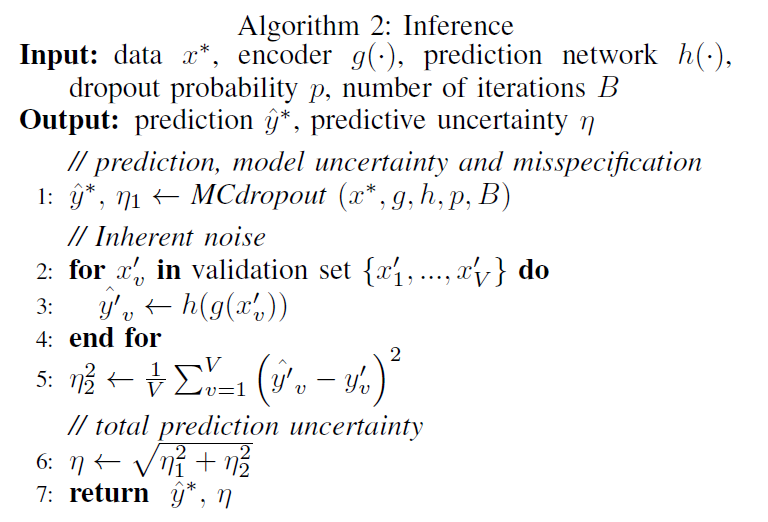Deep and Confident Prediction for Time Series at Uber (2017, 270)
Contents
- Abstract
- Introduction
- Related Works
- BNN
- Method
- Prediction Uncertainty
- Model Design
0. Abstract
“Uncertainty Estimation” using probabilistic TS forecasting
- propose a novel end-to-end Bayesian Deep Model
1. Introduction
prediction uncertainty can be decomposed into….
- 1) model uncertainty ( = epsitemic uncertainty )
- captures ignorance of model parameters
- can be reduced with more samples
- 2) inherent noise
- irreducible
- 3) model misspecification
- test sample from different population
\(\rightarrow\) propose a principled solution to incorporate this uncertainty
( using encoder-decoder framework )
2. Related Works
(1) BNN
find the posterior disn of \(W\)
-
exact posterior inference is rarely available
\(\rightarrow\) use approximate Bayesian Inference
How about, without changing NN architecture?
\(\rightarrow\) MC Dropout
- easy to implement!
3. Method
Trained NN : \(f^{\hat{W}}(\cdot)\)
Goal : evaluate the UNCERTAINTY of the model prediction ( = \(\hat{y}^{*}=f^{\hat{W}}\left(x^{*}\right)\) )
-
quantify the prediction standard error \(\eta\),
so that \(\alpha\)-level prediction interval be \(\left[\hat{y}^{*}-z_{\alpha / 2} \eta, \hat{y}^{*}+z_{\alpha / 2} \eta\right]\)
(1) Prediction Uncertainty
Gaussian Prior : \(W \sim N(0, I)\)
Model : \(y \mid W \sim N\left(f^{W}(x), \sigma^{2}\right)\).
Variance of the prediction distn :
\(\begin{aligned} \operatorname{Var}\left(y^{*} \mid x^{*}\right) &=\operatorname{Var}\left[\mathbb{E}\left(y^{*} \mid W, x^{*}\right)\right]+\mathbb{E}\left[\operatorname{Var}\left(y^{*} \mid W, x^{*}\right)\right] \\ &=\operatorname{Var}\left(f^{W}\left(x^{*}\right)\right)+\sigma^{2} \end{aligned}\).
- term 1 : \(\operatorname{Var}\left(f^{W}\left(x^{*}\right)\right)\)
- model uncertainty
- term 2 : \(\sigma^{2}\)
- inherent noise
- underlying assumption :
- \(y^{*}\) is generated by the same procedure
Therefore, propose with “3 sources”
- 1) model uncertainty
- 2) model misspecification
- 3) inherent noise level
(a) Model Uncertainty
-
posterior distn \(p(W \mid X, Y)\)
-
use MC dropout to estimate model uncertainty
\(\rightarrow\) approximate it with “sample variance”
\(\widehat{\operatorname{Var}}\left(f^{W}\left(x^{*}\right)\right)=\frac{1}{B} \sum_{b=1}^{B}\left(\hat{y}_{(b)}^{*}-\overline{\hat{y}}^{*}\right)^{2}\).
- where \(\overline{\hat{y}}^{*}=\frac{1}{B} \sum_{b=1}^{B} \hat{y}_{(b)}^{*}\)
- repeat prediction \(B\) times ( \(\left\{\hat{y}_{(1)}^{*}, \ldots, \hat{y}_{(B)}^{*}\right\}\) )
-
choose optimal dropout probability \(p\) adaptively
( treat it as a model parameter )
(b) Model Misspecification
- capture potential model misspecification
- by introducing “encoder-decoder” frameowork
- Step
- step 1) train an ENCODER ( \(g(\cdot)\) )
- step 2) reconstruct with DECODER ( \(h(\cdot)\) )
- treat them as one large network ( \(f=h(g(\cdot))\) )


(c) Inherent noise
-
estimate \(\sigma^2\)
-
(original MC dropout) implicitly determined by prior over smoothness of \(W\)
-
(proposal)
-
simple & adaptive approach
-
estimate the noise level via “the residual sum of squares”,
evaluated on an independent held-out validation set
-
-
Notation
- \(f^{\hat{W}}(\cdot)\) : fitted model on “training data”
- \(X^{\prime}=\left\{x_{1}^{\prime}, \ldots, x_{V}^{\prime}\right\}, Y^{\prime}=\left\{y_{1}^{\prime}, \ldots, y_{V}^{\prime}\right\}\) : independent validation set
- estimate \(\hat{\sigma}^{2}=\frac{1}{V} \sum_{v=1}^{V}\left(y_{v}^{\prime}-f^{\hat{W}}\left(x_{v}^{\prime}\right)\right)^{2}\)
- asymptotically unbiased estimation of true model!

(2) Model Design
2 components
- 1) encoder-decoder
- 2) prediction network
(a) encoder-decoder
- encoder input : \(\left\{x_{1}, \ldots, x_{T}\right\}\)
- decoder input : \(\left\{x_{T-F+1}, \ldots, x_{T}\right\}\)
- decoder output : \(\left\{x_{T+1}, \ldots, x_{T+F}\right\}\)
(b) prediction network
After ‘encoder-decoder’ is pre-trained!
use MLP
(c) Inference
after full model is trained, make inference!
\(\eta\) contains 2 terms
-
1) model uncertainty
-
2) misspecification uncertainty
( both estimated by MC dropout )
with held-out validation set,
- 3) inherent noise level
2 hyperparameters
- 1) dropout probability, \(p\)
- 2) number of iterations, \(B\)
